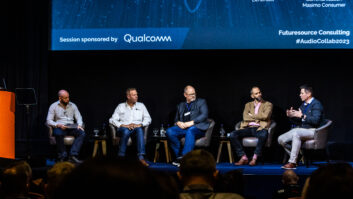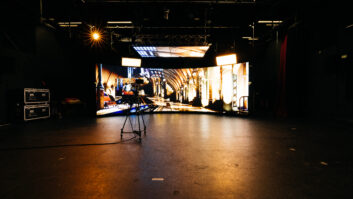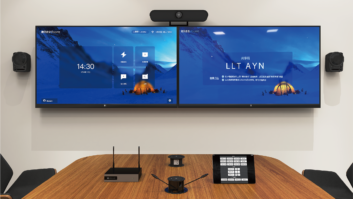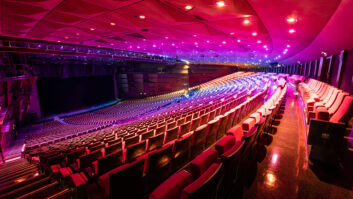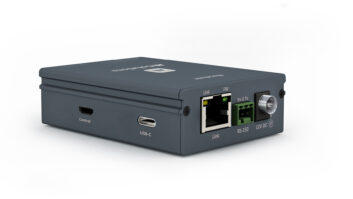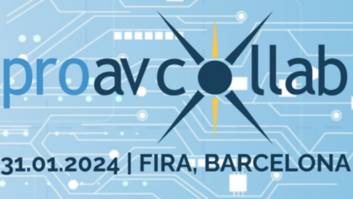If a week is a long time in politics, as former UK Prime Minister Harold Wilson once remarked, then a year can feel like a very long time in the world of corporate AV. From a period where the focus tended to be on equipping offices and conference rooms to the highest possible standard, the emphasis had to switch – sometimes quite literally over night – to wholesale home-based working and the ability to have employees carry on their jobs without access to their usual systems.
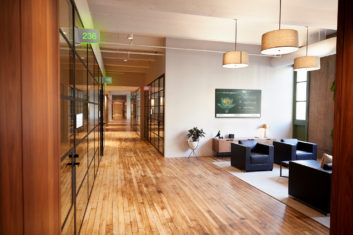 But this is by no means the whole story, and it’s important to note that several continuing trends were in progress long before the pandemic. Virtualisation of systems is one obvious example, allowing more flexible working patterns and easier collaboration with other organisations. Corporate clients were also becoming more conversant with the flexibility of network-based installations, opting in some cases to bring their AV and IT systems into one core infrastructure.
But this is by no means the whole story, and it’s important to note that several continuing trends were in progress long before the pandemic. Virtualisation of systems is one obvious example, allowing more flexible working patterns and easier collaboration with other organisations. Corporate clients were also becoming more conversant with the flexibility of network-based installations, opting in some cases to bring their AV and IT systems into one core infrastructure.
Indeed, as AVIXA senior staff instructor Chuck Espinoza remarks, Covid-19 will ultimately be regarded as an “accelerator of trends in the pro-AV industry”. This will mean continued rewards for those companies who are moving away from a hardware-centric model and have expertise in both AV and IT. But for manufacturers of larger physical systems, such as those typically used in conference facilities, the future appears more uncertain as both working and financial conditions remain unpredictable.
Drivers of change
Installation spoke to a broad cross-section of vendors, installers, consultants and end-users for this article, and the convergence of AV-IT was widely cited as being one of the defining trends prior to the pandemic. As Stijn Ooms, director product strategy AV and digital workplace at Crestron, observes, this has had implications for the deployment of technology and personnel.
“Previously, AV and IT both had a completely different focus,” he recalls. “AV wanted to make the most out of any technology, while IT focused more on scalability and usability. The intertwining of both departments meant that companies were more and more looking for AV and UC technology that was flexible, scalable, and easy to use and deploy, while at the same time offering a plenitude of possibilities
in the backend.”
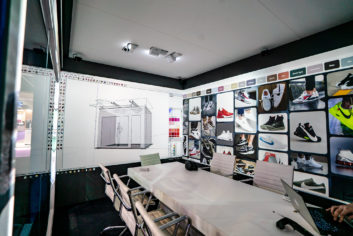 Espinoza also alludes to the traction being experienced by UC as well as the emergence of software-driven AVaaS (AV as a System). “The corporate market was starting to move to a virtual environment little by little, and new technologies were slowly making it happen,” he says. “We have already seen enterprises that do AVaaS because of the realisation that new technology comes out faster
Espinoza also alludes to the traction being experienced by UC as well as the emergence of software-driven AVaaS (AV as a System). “The corporate market was starting to move to a virtual environment little by little, and new technologies were slowly making it happen,” he says. “We have already seen enterprises that do AVaaS because of the realisation that new technology comes out faster
than ‘new money’. The desire to invest in a permanent infrastructure was growing smaller because technology managers were looking at future expansions or UC.”
Colin Yellowley, R&D director at Igloo Vision, also emphasises the long-term growing importance of collaboration. “How do you use AV technologies to bring together disparate teams, including remotely located team members, and enable them all to view and interrogate the technology tools they use in their project-planning and decision-making?” he says of a frequent starting-point for corporate AV projects. “Immersive rooms and workspaces were already being touted by the likes of Gartner, PwC and NTT pre-pandemic as a solution.”
Soft conferencing
Along with the implementation of “soft conferencing platforms like Zoom and Teams”, Atlona director of marketing Garth Lobban highlights the increased reliance on a BYOD strategy. “We were working to modernise the corporate space by equipping rooms with USB-C and other connectivity technologies that allowed people to walk in and launch meetings by simply connecting their laptops and personal devices.”
As part and parcel of a corporate environment that is “more connected” and leans increasingly towards “smart working”, it’s no surprise that IP-based network infrastructures were also in the process of becoming more commonplace.
“IP structures are extremely flexible and provide high bandwidths to help teams collaborate, but also to take project management as a whole to a new level,” says Guntermann & Drunck GmbH director of sales and marketing Jochen Bauer. “We are moving more and more into a hybrid and networked world. But we still look forward to the day when we will again be able to meet and work together face-to-face.”
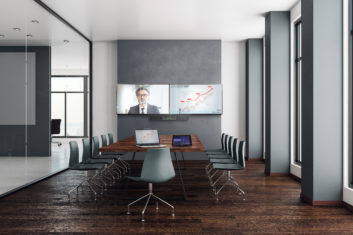 Still, for all the change that was undoubtedly in progress before the pandemic, no one disputes the paradigm-shifting nature of Covid-19. Jon Sidwick, president of Collabtech Group, remarks: “Change was happening in the same direction of travel that we’ve now seen, but it wasn’t happening so quickly. Change is usually made up multiple micro developments to reach a macro milestone, so we don’t notice when a big shift has happened. The pandemic has accelerated this dramatically and I think we’ve seen approximately five years of change in ten months.”
Still, for all the change that was undoubtedly in progress before the pandemic, no one disputes the paradigm-shifting nature of Covid-19. Jon Sidwick, president of Collabtech Group, remarks: “Change was happening in the same direction of travel that we’ve now seen, but it wasn’t happening so quickly. Change is usually made up multiple micro developments to reach a macro milestone, so we don’t notice when a big shift has happened. The pandemic has accelerated this dramatically and I think we’ve seen approximately five years of change in ten months.”
New investments
There is also a feeling that the pandemic will necessitate new investments by corporate AV customers, even those who have been more reluctant to embrace developments such as virtualisation. “Tech managers have been thinking about how to do the things that Covid-19 has FORCED us to do,” says Espinoza. “Many times [in the past] the stalemate was corporate culture, refusing to buy in. Tech managers have a lot of boxes to manage, and now with everyone working from home there are less boxes for them to manage, but more endpoints. Having all the endpoints talk to each other is no longer about the physical connection… now we have a slew of other issues!”
Providing an end-user perspective, a member of the AV User Group [who preferred to remain anonymous] says that the pandemic is an incentive to further refine virtual and/or hybrid meeting scenarios. “It can be a challenge if you are doing a hybrid meeting with, for example, five people in a room and then three remote contributors,” he says. “It’s not always easy to have people framed well and able to see each other, and to tell who is speaking at any given time. The pandemic has [provided a prompt] to ensure that the hybrid meeting experience is better with, for example, auto-framing and high-quality speakers.”
The AVUG member also indicates that meeting room set-ups will remain something of a moving target. “New ways of working are emerging thanks to [solutions such as] Microsoft 365,” he says. “I expect that a lot of thought will continue to go into optimising technologies so they can support various methods of collaboration.”
As much as increased remote working has had technological implications, it has also meant a change in mindset at a senior level in many corporations. Managers and enterprises who were previously sceptical of home working have now come to realise its potential practical and financial plus-points.
“For the price of a laptop and a few peripherals – which they were already providing to their employees anyway – and a change in attitude when it comes to their hiring practices and corporate culture, they have found out that their employees can be just as productive and successful working from pretty much anywhere,” says Espinoza.
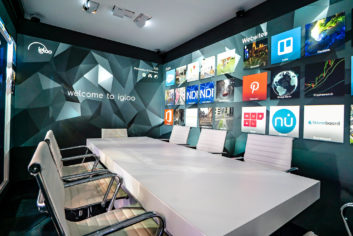 All of which means that future investments in both AV and IT are likely to be determined by a different approach to the workplace in which it tends to be used by a smaller number of people at any one time and for more targeted purposes.
All of which means that future investments in both AV and IT are likely to be determined by a different approach to the workplace in which it tends to be used by a smaller number of people at any one time and for more targeted purposes.
“The need for a centralised workplace has changed,” says Sidwick. “Work is now a destination – somewhere that people go when they have a specific requirement. This might be to work collaboratively with others, for creativity, inspiration and those ad hoc ‘water cooler’ moments that can be invaluable for sparking a great idea.”
The degree of transformation will obviously be informed by the type of corporation and the size of workforce involved, but some preparation of staff will be essential – especially if they are returning after an extended period of being based at home.
“People are going to be phased if they walk into a space that they once knew and find it looking completely different 12 months on,” says Sidwick. “So training needs to be considered to make sure that everyone knows how to use any new digital workflow solution to ensure a high adoption.”
Changing behaviours
Of course, AV technology companies have themselves had to adapt to changing working behaviours during the pandemic. Indeed, Lobban observes that it provided a useful window in which to reflect on the requirements of a changing sector.
“It gave companies like Atlona the opportunity to regroup and consider how we could help to keep businesses in motion and keep people working collaboratively, he says. “That included our own business as the pandemic forced most of us to retreat to our home offices.”
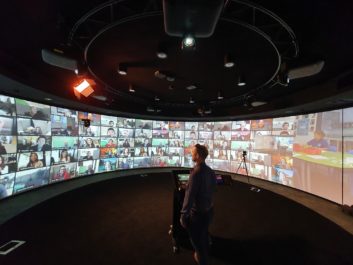 Indeed, there is no denying that the last 12 months may prove to have been highly insightful in terms of parity of experience between AV companies and corporate clients. Sidwick remarks: “2020 allowed us to conduct the largest experience ever into working from home and we’ve discovered that, in general, it works! People have done a great job at adapting and with the right technologies, platforms and processes in place, the digital workflow has remained strong.”
Indeed, there is no denying that the last 12 months may prove to have been highly insightful in terms of parity of experience between AV companies and corporate clients. Sidwick remarks: “2020 allowed us to conduct the largest experience ever into working from home and we’ve discovered that, in general, it works! People have done a great job at adapting and with the right technologies, platforms and processes in place, the digital workflow has remained strong.”
Not surprisingly, the actual physical installation of systems in corporate environments has become more problematic – and is likely to remain so as long as we are in a cycle of lockdowns. Yellowley recalls a common concern: “How can we send installation teams to client sites in the face of lockdowns, closed borders or quarantines? Several time during the pandemic, we’ve had entire teams sitting out a two-week quarantine in a rental apartment, installing the system, then having to self-isolate again after the return journey.”
Fresh facets
But out of this has also come a fresh facet of the business in collaboration with local partners. “We’ve focused much more on remote installations and have partnered with local integrators, and that’s definitely going to be business-as-usual going forward,” says Yellowley. “Of course, some projects were pulled. But, overall, the pandemic has increased the rationale for our technologies – we’ve been among the lucky ones.”
As the vaccination roll-out continues and (we hope) the impact of the pandemic diminishes, it’s inevitable that corporate clients will be giving thought to future AV requirements. Given their experiences over the last 12 months, it’s highly probable that a lot of new investments will focus on solutions that can improve the quality of collaboration – for example, higher-quality video and the ability to manage and monitor network infrastructures remotely.
“It will be necessary to put more AV components and AV content on the network,” says Lobban. “As we look for ways to accommodate more people across more spaces simultaneously, AV-over-IP networking will be critical to addressing these meeting overflow requirements. To get there, it’s imperative that we continue to strengthen relationships with the IT professionals that are still relatively new to AV, and develop products and solutions that speak to how
they operate.”
Improved emphasis
Equipment-wise, Lobban expects companies to place an emphasis on technologies that can improve video quality for home-based employees. “Working from home over the long haul will require many to invest in better equipment for meetings, lectures and classes. This is why we have seen a rise in the SoHo market (small office/home office) and a greater emphasis on PTZ cameras in our industry. People are investing in these cameras for home offices to create that more professional appearance for their meetings and classes.”
Ooms predicts spend on UC and technology that supports safer working. “For instance, projects that combine low-touch and no-touch control with scheduling panels that show meeting room availability without the need to open the door, people counting and motion sensors, and video in every room. And a lot of companies also focus on the comfort of their workforce at home, with solutions [such as our] Crestron Home Tabletop Conferencing Device.”
As much as they can be profoundly challenging, crises also tend to generate new opportunities – especially for companies who are responsive and open to collaboration. Hence multiple interviewees expressed an eagerness to ‘seize the day’ and address the long-term requirements of the corporate sector.
“AV suppliers can actively influence the evolution of new workspaces,” asserts Sidwick. “We are already becoming the workplace consultants to drive the evolution of workflow, space and technology.
By partnering with the right companies, service providers and facilities management specialists,
we can further integrate people, place and process within the built environment to improve user experiences and enhance productivity.”
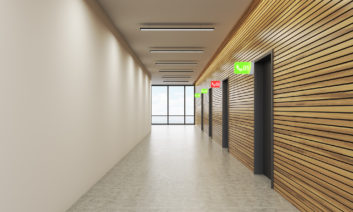 Installation rounded out its conversations with AV companies who asking them for their long-term predictions about the corporate market. The responses further underlined the importance of strong, multi-faceted collaboration systems, but also touched on the role that AV training and data-driven business models will play.
Installation rounded out its conversations with AV companies who asking them for their long-term predictions about the corporate market. The responses further underlined the importance of strong, multi-faceted collaboration systems, but also touched on the role that AV training and data-driven business models will play.
Yellowley focuses on meeting room configuration: “For as long as I can remember, most meeting rooms have looked almost identical – a large rectangular table, surrounded by chairs, in a rectangular room with a single screen on one wall. In the next few years that’s going to change. Many more of them will be equipped with room-scale displays, so that there’s no more endless flicking between data sources, and team members can share multiple streams of content from multiple locations and devices – all at the same time.”
Permanent systems
The need for some kinds of permanent system is likely to diminish, says Espinoza: “Look out for
more short-term leasing of equipment or AVaaS. I don’t see smaller corporate clients wanting to put as much money into their infrastructure and presentation equipment. I think they would rather put their money into people who can work in any location. If they don’t have to put money towards boxes, they will have money to spend on quality people who will work from any location.”
Ooms is not alone in predicting the increasing utilisation of artificial intelligence, not least with regard to data collection that can allow companies to make more informed decisions: “The unexpected and unprecedented pandemic showed companies how useful data can be. They want more than to just collect data. Instead, they want to use AI on the collected big data. For instance, instead of just knowing that a room is booked, they want to know if it was actually used, by how many people, and what technology was used.
“Releasing AI on the collected data allows companies
to make a correct decision when deciding on an investment, instead of simply following their gut. Soon we will also have the technology available that could even help predict issues before they arise, [allowing the] IT/AV team to prevent or solve them before they are an inconvenience.”
Technological trendsetters
Professional AV has long had a reputation as a technological trendsetter, especially when it comes to audio and video. In the future, it may need to work even harder to keep up with the expectations of corporate AV customers, and it is certain that those companies who can fuse AV and IT expertise will have the healthiest order books. Another certainty is that the rocket-fuelled accelerated change as a result of Covid is set to continue.
